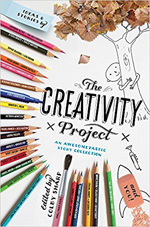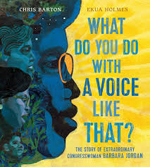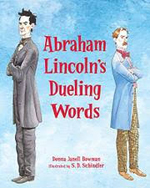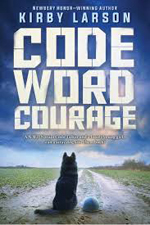ILA’s first-ever Children’s Literature Day, an entire day of programming dedicated to children’s and young adult literature, will debut at the ILA 2018 Conference, taking place July 20–23 in Austin, Texas. This week’s column features spotlighted books by keynote speakers and Putting Books to Work (Early Reader and Middle Grade) authors and facilitators, who will work with attendees to deliver title-focused materials and practical ideas for putting books "to work" in the classroom.
Keynote speakers
The Creativity Project: An Awesometastic Story Collection. Colby Sharp (Ed.). 2018. Little, Brown.
 Colby Sharp challenged 44 authors and illustrators (including Jennifer Holm, Minh Lê, Linda Sue Park, Andrea Davis Pinkney, and Javaka Steptoe) to submit story starters (photos, drawings, cartoons, poems, and prose) for each other. They responded by transforming the prompts into creative works. For example, in response to Margarita Engle’s story starter (a haiku about a road trip), Debbie Ridpath Ohi created a comic strip, “Road Trip,” while Engle responded to Grace Lin’s photo prompt (a child racing across a bridge) with a poem about a puppy following a running girl. The final section includes prompts for readers to respond to creatively. Back matter includes biographical notes on the contributors and an index.
Colby Sharp challenged 44 authors and illustrators (including Jennifer Holm, Minh Lê, Linda Sue Park, Andrea Davis Pinkney, and Javaka Steptoe) to submit story starters (photos, drawings, cartoons, poems, and prose) for each other. They responded by transforming the prompts into creative works. For example, in response to Margarita Engle’s story starter (a haiku about a road trip), Debbie Ridpath Ohi created a comic strip, “Road Trip,” while Engle responded to Grace Lin’s photo prompt (a child racing across a bridge) with a poem about a puppy following a running girl. The final section includes prompts for readers to respond to creatively. Back matter includes biographical notes on the contributors and an index.
—NB
Marley Dias Gets It Done: And So Can You! Marley Dias. 2018. Scholastic.
 Marley Dias made headlines as a sixth grader when she began the #1000BlackGirlBooks initiative to collect and donate books with young black female protagonists. Since then, Dias has achieved national acclaim for her work as an advocate for literacy and social justice. With colorful photos, dropped quotes, and interesting sidebars, the book explores activism, equity and inclusion, social media for good, book talking, and more and delivers hands-on strategies for becoming a lifelong reader. Readers of all ages will admire and be inspired by Dias’ passion to make the world a better place.
Marley Dias made headlines as a sixth grader when she began the #1000BlackGirlBooks initiative to collect and donate books with young black female protagonists. Since then, Dias has achieved national acclaim for her work as an advocate for literacy and social justice. With colorful photos, dropped quotes, and interesting sidebars, the book explores activism, equity and inclusion, social media for good, book talking, and more and delivers hands-on strategies for becoming a lifelong reader. Readers of all ages will admire and be inspired by Dias’ passion to make the world a better place.
—SK
Solo. Kwame Alexander (with Mary Rand Hess). 2017. Blink/HarperCollins.
 How does it feel / to be the daughter / to be the son / of a fallen rock star? For 17-year-old Blade Morrison, son of an alcoholic, drug-addicted, former rock star, two things make his life bearable: his girlfriend, Chapel, and his guitar. When the reveal of a family secret leads Blade to travel to Ghana, he embarks on a journey of self-discovery, during which he finds answers about his past and hope for his future in the remote village of Konko. This coming-of-age story is told through beautifully crafted poems filled with references to classic rock music.
How does it feel / to be the daughter / to be the son / of a fallen rock star? For 17-year-old Blade Morrison, son of an alcoholic, drug-addicted, former rock star, two things make his life bearable: his girlfriend, Chapel, and his guitar. When the reveal of a family secret leads Blade to travel to Ghana, he embarks on a journey of self-discovery, during which he finds answers about his past and hope for his future in the remote village of Konko. This coming-of-age story is told through beautifully crafted poems filled with references to classic rock music.
—CA
Putting Books to Work: Early Reader (ages 4–8)
Charlie Takes His Shot: How Charlie Sifford Broke the Color Barrier in Golf. Nancy Churnin. Ill. John Joven. 2018. Albert Whitman.
 Charles Luther Sifford (1922–2015) caddied at the private all-white Carolina Country Club, honed his golfing skills on public courses, and won the National Negro Open six times. Despite these accomplishments, he was forbidden to play in the Professional Golfers’ Association of America (PGA), due to the color of his skin. Inspired by Jackie Robinson and aided by Stanley Mosk, former attorney general of California who petitioned the PGA to overturn its “Caucasian-only” clause, Sifford became the first black golfer to join the PGA Tour in 1961 and to be inducted in the World Golf Hall of Fame in 2004. An engaging, accessible narrative and expressive mixed-media illustrations portray the determination of this notable sports figure, who paved the way for golfers of color. Back matter includes an author’s note and a timeline.
Charles Luther Sifford (1922–2015) caddied at the private all-white Carolina Country Club, honed his golfing skills on public courses, and won the National Negro Open six times. Despite these accomplishments, he was forbidden to play in the Professional Golfers’ Association of America (PGA), due to the color of his skin. Inspired by Jackie Robinson and aided by Stanley Mosk, former attorney general of California who petitioned the PGA to overturn its “Caucasian-only” clause, Sifford became the first black golfer to join the PGA Tour in 1961 and to be inducted in the World Golf Hall of Fame in 2004. An engaging, accessible narrative and expressive mixed-media illustrations portray the determination of this notable sports figure, who paved the way for golfers of color. Back matter includes an author’s note and a timeline.
—NB
God Bless America: The Story of an Immigrant Named Irving Berlin. Adah Nuchi. Ill. Rob Polivka. 2018. Hyperion.
 In 1893, five-year-old Izzy Baline and his family arrived in New York City after escaping Jewish persecution in Russia. Inspired by the music all around him, young Baline decided to become a songwriter. By age 26, he had written 200 songs and had given himself a new name: Irving Berlin. In 1938, with U.S. involvement in another world war imminent, Berlin wrote “God Bless America,” which became the rallying song for Americans everywhere. This biography of his life includes an informative author’s note, timeline, websites, and sources.
In 1893, five-year-old Izzy Baline and his family arrived in New York City after escaping Jewish persecution in Russia. Inspired by the music all around him, young Baline decided to become a songwriter. By age 26, he had written 200 songs and had given himself a new name: Irving Berlin. In 1938, with U.S. involvement in another world war imminent, Berlin wrote “God Bless America,” which became the rallying song for Americans everywhere. This biography of his life includes an informative author’s note, timeline, websites, and sources.
—SK
What Do You Do With a Voice Like That?: The Story of Extraordinary Congresswoman Barbara Jordan. Chris Barton. Ill. Ekua Holmes. 2018. Beach Lane/Simon & Schuster.
 Growing up in Houston, Barbara Jordan (1936–1996) confidently used her strong voice. After graduating from law school at Boston University, she returned to her home city, where she became involved in politics and was eventually elected as the first black woman to serve in the Texas state senate and, years later, the first black Texan to serve in Congress. Ending her service in government in 1979, she continued to use her voice to advocate for equality, justice, and trust by teaching courses in public policy and ethics in government at the University of Texas. This picture book biography about Congresswoman Jordan ends with an inspiring answer to the question posed in the title: “We remember it, and we honor it by making our own voices heard.” Back matter includes a timeline and bibliography.
Growing up in Houston, Barbara Jordan (1936–1996) confidently used her strong voice. After graduating from law school at Boston University, she returned to her home city, where she became involved in politics and was eventually elected as the first black woman to serve in the Texas state senate and, years later, the first black Texan to serve in Congress. Ending her service in government in 1979, she continued to use her voice to advocate for equality, justice, and trust by teaching courses in public policy and ethics in government at the University of Texas. This picture book biography about Congresswoman Jordan ends with an inspiring answer to the question posed in the title: “We remember it, and we honor it by making our own voices heard.” Back matter includes a timeline and bibliography.
—CA
Putting Books to Work: Middle Grade (ages 8–12)
Abraham Lincoln’s Dueling Words. Donna Janell Bowman. Ill. S. D. Schindler. 2018. Peachtree.
 Young lawyer Abraham Lincoln was known for his mischievous, prank-playing sense of humor. But, in 1842, he took it too far; frustrated with the actions of James Shields, a political rival, Lincoln, his future wife, and a friend of hers wrote a series of fictional letters to the editor of the Sangamo Journal, in which they called Shields “a fool, liar, and conceity dunce.” Shields demanded a public apology and challenged Lincoln to a duel. The duel was about to commence when friends intervened and helped the two reach a face-saving compromise through words instead of swords. Schindler’s watercolor-and-ink illustrations complement Bowman’s humorous narrative. Back matter includes background for the story, an author's note, and links to expanded content and a bibliography.
Young lawyer Abraham Lincoln was known for his mischievous, prank-playing sense of humor. But, in 1842, he took it too far; frustrated with the actions of James Shields, a political rival, Lincoln, his future wife, and a friend of hers wrote a series of fictional letters to the editor of the Sangamo Journal, in which they called Shields “a fool, liar, and conceity dunce.” Shields demanded a public apology and challenged Lincoln to a duel. The duel was about to commence when friends intervened and helped the two reach a face-saving compromise through words instead of swords. Schindler’s watercolor-and-ink illustrations complement Bowman’s humorous narrative. Back matter includes background for the story, an author's note, and links to expanded content and a bibliography.
—NB
Code Word Courage (Dogs of World War II). Kirby Larson. 2018. Scholastic.
 Set during World War II, Kirby Larson presents a touching story about lonely, 11-year-old Billie; Denny, a Navajo code talker; and an injured, stray dog named Bear. On a visit before shipping out, Denny leaves Bear with Billie. Bear becomes both the best friend that Billie desperately needs and the vision that guides Denny to safety during battle. Heroism is found both on the war front and at home, and Bear is the thread that connects everyone in this story with themes of friendship, courage, and the healing love of a dog.
Set during World War II, Kirby Larson presents a touching story about lonely, 11-year-old Billie; Denny, a Navajo code talker; and an injured, stray dog named Bear. On a visit before shipping out, Denny leaves Bear with Billie. Bear becomes both the best friend that Billie desperately needs and the vision that guides Denny to safety during battle. Heroism is found both on the war front and at home, and Bear is the thread that connects everyone in this story with themes of friendship, courage, and the healing love of a dog.
—SK
Spy Runner. Eugene Yelchin. 2019. Godwin/Henry Holt.
 Scheduled to publish in February 2019, the publisher provided the following statement about Spy Runner: “It's 1953 and the Cold War is on. Communism threatens all that the United States stands for, and America needs every patriot to do their part. So when a Russian boarder moves into the home of 12-year-old Jake McCauley, he's on high alert. What does the mysterious Mr. Shubin do with all that photography equipment? And why did he choose to live so close to the Air Force base? Jake’s mother says that Mr. Shubin knew Jake’s dad, who went missing in action during World War II. But Jake is skeptical; the facts just don’t add up. And he’s determined to discover the truth—no matter what he risks.”
Scheduled to publish in February 2019, the publisher provided the following statement about Spy Runner: “It's 1953 and the Cold War is on. Communism threatens all that the United States stands for, and America needs every patriot to do their part. So when a Russian boarder moves into the home of 12-year-old Jake McCauley, he's on high alert. What does the mysterious Mr. Shubin do with all that photography equipment? And why did he choose to live so close to the Air Force base? Jake’s mother says that Mr. Shubin knew Jake’s dad, who went missing in action during World War II. But Jake is skeptical; the facts just don’t add up. And he’s determined to discover the truth—no matter what he risks.”
Carolyn Angus is former director of the George G. Stone Center for Children's Books, Claremont Graduate University, in Claremont, California. Nancy Brashear is Professor Emeritus of English from Azusa Pacific University, in Azusa, California. Susan Knell is a professor in the department of Teaching and Leadership at Pittsburg State University in Pittsburg, Kansas, where she teaches literacy and literature courses at the undergraduate and graduate level.
These reviews are submitted by members of the International Literacy Association's Children's Literature and Reading Special Interest Group (CL/R SIG) and are published weekly on Literacy Daily.